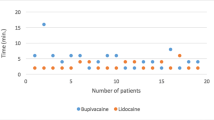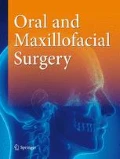Abstract
Introduction
Efficacy of anesthetic supplementation with bupivacaine to control both pain and the number of analgesics ingested after surgery has been proposed; however, no report was found in the literature regarding supplemental use of bupivacaine. Thus, the aim of this study was to evaluate the clinical efficacy of bupivacaine in appeasing postoperative pain, when used as supplemental anesthesia at the end of surgeries to extract mandibular third molars.
Methods
Eighty surgeries were performed in 40 healthy ASA I patients of mandibular bilateral, semi-enclosed, and symmetrical third molars, in a randomized, double-blind, placebo-controlled, and split-mouth clinical trial. Two procedures were performed. In one case, a preoperative anesthetic block was performed with bupivacaine (0.5 %) and epinephrine (1:200,000). Supplementation with the same anesthetic composition was used at the end of the surgery (test group). In the second case (control group), the procedure was identical to that used in the test group, but was supplemented in a randomized double-blind trial with saline (placebo), using the split-mouth method. Postoperative pain (measured with a visual analog scale) was the primary variable studied, and analgesic consumption was the secondary variable. Nonparametric analysis of variance (Wilcoxon test) and a two-tailed test to determine the ratio was used. P value was set at 0.05.
Results
No statistically significant difference (P > 0.05) was found in the variables studied. An adverse effect related to the anesthetic under study was not observed.
Conclusion
There is no appreciable value to the second injection regarding pain and analgesia use, but there was a difference regarding patient acceptance in surgeries of mandibular semi-enclosed and impacted third molars.




Similar content being viewed by others

References
Joshi A, Parara E, Macfarlane T (2004) A double-blind randomised controlled clinical trial of the effect of preoperative ibuprofen, diclofenac, paracetamol with codeine and a placebo tablets for relief of postoperative pain after removal of impacted third molar. Br J Oral Maxillofac Surg 42:299–306
Mehrabi M, Allen JM, Roser SM (2007) Therapeutic agents in perioperative third molar surgical procedures. Oral Maxillofac Surg Clin N Am 19:69–84
Buyukkurt MC, Gungormus M, Kaya O (2006) The effect of a single dose prednisolone with and without diclofenac on pain, trismus and swelling after removal of mandibular third molars. J Oral Maxillofac Surg 64:1761–1766
Trieger N, Gillen GH (1979) Bupivacaine anesthesia and postoperative analgesia in oral surgery. Anesth Prog 26:20–23
Chapman PJ, Mc Leod AWG (1985) A clinical study of bupivacaine for mandibular anesthesia in oral surgery. Anesth Prog 32:69–72
Rosenquist JB, Rosenquist KI, Lee MKP (1988) Comparison between lidocaine and bupivacaine as local anesthetics with diflunisal for postoperative pain control after lower third molar surgery. Anesth Prog 35:1–4
Markovic AB, Todorovic L (2006) Postoperative analgesia after lower third molar surgery: contribution of the use of long-acting local anesthetics, low-power laser, and diclofenac. Oral Surg Oral Med Oral Pathol Oral Radiol Endod 102:4–8
Malamed SF (2005) Manual de Anestesia local. Guanabara Koogan, Rio de Janeiro
Trullenque-Eriksson A, Guisado-Moya B (2011) Comparative study of two local anesthetics in the surgical extraction of mandibular third molars: bupivacaine and articaine. Med Oral Patol Oral Cir Bucal 16:e390–e396
Albright GA (1979) Cardiac arrest following regional anesthesia with etidocaine or bupivacaine. Anesthesiology 51:285–287
Bacsik CJ, Swift JQ, Hargreaves KM (1995) Toxic systemic reactions of bupivacaine and etidocaine. Oral Surg Oral Med Oral Pathol Oral Radiol Endod 79:18–23
Gregorio LVL, Giglio FPM, Sakai VT, Modena KC, Colombini BL, Calvo AM et al (2008) A comparison of the clinical anesthetic efficacy of 4 % articaine and 0.5 % bupivacaine (both with 1:200.000 epinephrine) for lower third molar removal. Oral Surg Oral Med Oral Pathol Oral Radiol Endod 106:19–28
Younessi J, Punnia-Moorthy A (1999) Cardiovascular effects of bupivacaine and the role of this agent in preemptive dental analgesia. Anesth Prog 46:56–62
Pell G, Gregory B (1933) Impacted mandibular third molars: classification and modified techniques for removal. Dent Dig 39:330–338
Peterson LJ, Ellis E, Hupp JR, Tucker MR (2000) Guanabara Koogan. Rio de Janeiro
Brunner E, Langer F (2000) Nonparametric analysis of ordered categorical data in designs with longitudinal observations and small sample sizes. Biom J 42:663–675
Meechan JG, Seymour RA (1993) The use of third molar surgery in clinical pharmacology. Br J Oral Maxillofac Surg 31:360–365
Siddiqi A, Morkel JA, Zafar Z (2010) Antibiotic prophylaxis in third molar surgery: a randomized double-blind placebo-controlled clinical trial using split-mouth technique. Int J Oral Maxillofac Surg 39:107–114
Bauer HC, Duarte FL, Horliana AC, Tortamano IP, Perez FE, Simone JL, Jorge WA (2013) Assessment of preemptive analgesia with ibuprofen coadministered or not with dexamethasone in third molar surgery: a randomized double-blind controlled clinical trial. Oral Maxillofac Surg 17:165–171
Jebeles JA, Reilly JS, Gutierrez JF, Bradley EL, Kissin I (1993) Tonsillectomy and adenoidectomy pain reduction by local bupivacaine infiltration in children. Inter J Ped Otorh 25:149–154
Gordon SM, Dionne RA, Brahim J, Jabir F, Dubner R (1997) Blockade of peripheral neuronal barrage reduces postoperative pain. Pain 70:209–215
Bouloux GF, Punnia-Moorthy A (1999) Bupivacaine versus Lidocaine for third molar surgery: a double-blind, randomized, crossover study. J Oral Maxillofac Surg 57:510–514
Hargreaves KM, Keiser K (2002) Development of new pain management strategies. J Dent Educ 66:113–121
Nayyar MS, Yates C (2006) Bupivacaine as pre-emptive analgesia in third molar surgery: randomised controlled trial. Br J Oral Maxillofac Surg 44:501–503
Carvalho VH, Braga AFA, Braga FSS, Loyola YCS, Araújo DR, Mantovani M (2009) The influence of lidocaine and racemic bupivacaine on neuromuscular blockade produced by rocuronium. A study in rat phrenic nerve-diaphragm preparation. Acta Cir Bras 24:211–216
Pricco DF (1977) Na evaluation of bupivacaine for regional nerve block in oral surgery 35:126–129
Chapnik P, Baker G, Munroe CO (1980) Bupivacaine anesthesia in oral surgery. J Can Dent Assoc 46:441–443
Hyrkäs T, Yllipaavalniemi P, Oikarinen VJ, Paakkari I (1994) Effective postoperative pain prevention through administration of bupivacaine and diclofenac. Anesth Prog 41:6–10
Modi M, Sanjay R, Kumar A (2009) Buprenorphine with bupivacaine for intraoral nerve blocks to provide postoperative analgesia in outpatients after minor oral surgery. J Oral Maxillofac Surg 67:2571–2576
Conflict of interest
The authors declare that they have no conflict of interest.
Author information
Authors and Affiliations
Corresponding author
Rights and permissions
About this article
Cite this article
de Souza, A.M.M., Horliana, A.C.R.T., Simone, J.L. et al. Postoperative pain after bupivacaine supplementation in mandibular third molar surgery: splint-mouth randomized double blind controlled clinical trial. Oral Maxillofac Surg 18, 387–391 (2014). https://doi.org/10.1007/s10006-014-0471-4
Received:
Accepted:
Published:
Issue Date:
DOI: https://doi.org/10.1007/s10006-014-0471-4



